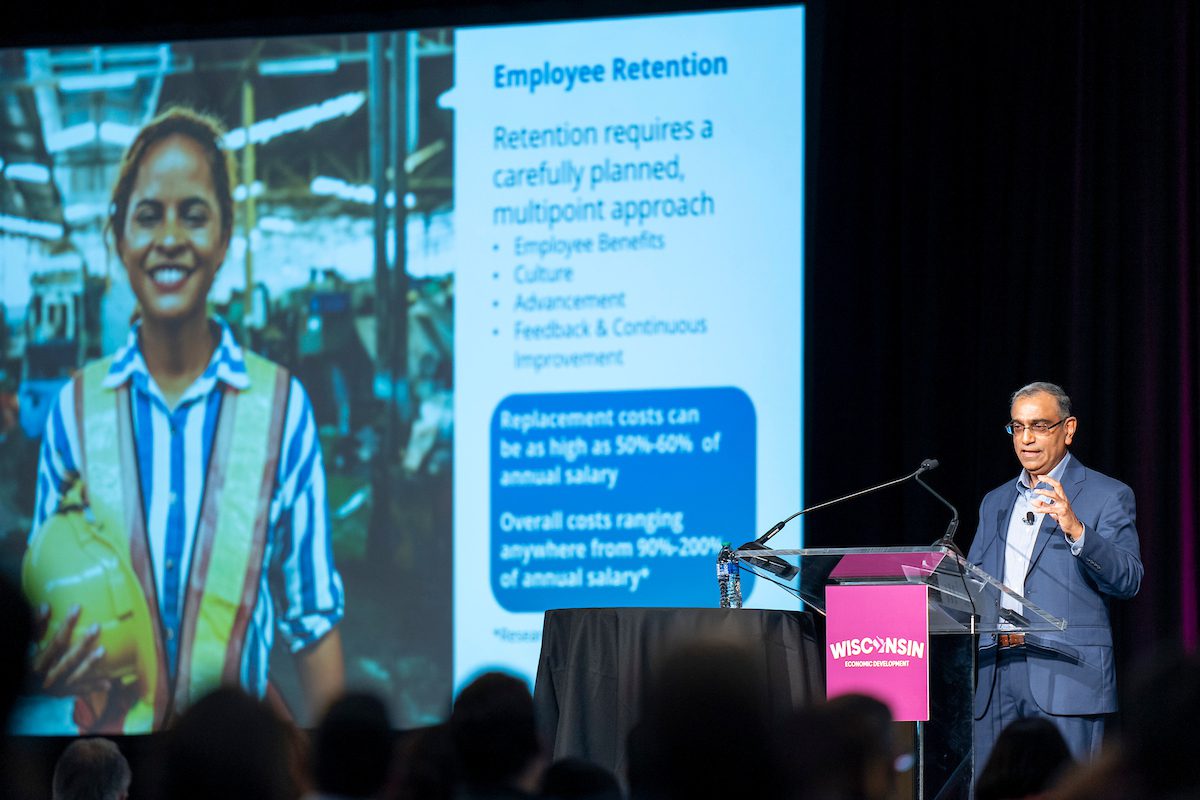The scarcity of labor in today’s markets demands new approaches to workforce development that account for changing worker expectations and build healthier workplace cultures.
That was the message delivered by Chris Baichoo, executive director and CEO of WMEP Manufacturing Solutions, to the Wisconsin Economic Summit, hosted by WEDC in Appleton on Oct. 23.
Baichoo said a recent survey of 415 Wisconsin manufacturers indicated that 81% were struggling to find qualified workers. Filling those jobs requires a new hiring outlook, and keeping them demands a new workplace culture, he said: “You’ve got to have a marketing mindset. And what that means is you’ve got to start treating your employees as customers. You’ve got to give them what they want so they come on board.”

Chris Baichoo, Executive Director & CEO of WMEP Manufacturing Solutions, shared insight on people-centered change management during the session topic ‘Educating Tomorrow’s Workforce.’ Wisconsin Economic Summit WEDC Oct. 23, 2023. (Photo © Andy Manis)
Employers need to be purposeful in their hiring, developing a well-defined corporate culture, conveying their role on social responsibility issues, and selling employees on a value proposition—and applications should be easy to complete online, he added.
He noted that the onboarding process itself can be a turnoff to new hires: “If you are onboarding employees, if they come in in the morning and they leave by lunch and they never show back up, you probably have a problem with your process. Was it your culture? Were you not adapting the onboarding process to the generation that you’re hiring?”
Baichoo said support for professional development provides an incentive for employees to apply and stay, with some companies setting up internal “universities” to train their workers. “Large companies like Sub-Zero are developing unique programs to help train new employees and bring them up to speed,” he said. “They recognize that they have to spend the effort there to develop their workforce.”
Especially as Baby Boomers retire, apprenticeships and mentorships can help capture institutional memory and carry on the culture and traditions established by companies, Baichoo added. “As you look at these employees retire, how do you set up mentorships to make sure that newer employees have a mentor to transfer that knowledge and to establish the culture of the company?”
Baichoo said building an inclusive, collaborative culture with sound values is also essential to succeed in the labor market and the workplace—and changing gears to abandon a my-way-or-the-highway approach is also important. “One of the things I’ve learned over the last couple of years is that understanding the strengths of every employee and customizing an advancement program that builds on their strength, whether it’s up or lateral—it’s really important to be able to understand how you make it fit,” he said.
Baichoo also said the difficulty in attracting employees points to a need to optimize products and customers that have the highest return on investment. For example, he suggested that manufacturers retire products at the end of their life cycle and redesign them to reduce the labor involved in production, and use that savings to invest in automation.
Training is also central for supervisors, Baichoo said, to ensure that they are not chasing employees out the door. “These are the people that make manufacturing businesses work,” he said. “If you have a poorly trained front-line leadership, you will suffer, believe you me. When they do their job really well, they help reduce turnover, they drive productivity, and they provide training on new changes where we look at employees as our customers and attend to their individual needs to keep them engaged.”
